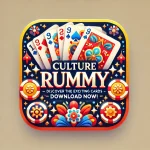Played with a standard 52-card deck, rummy is a popular card game. The goal of the game is to form sets and runs of cards in your hand, and it usually involves two to six players. A run is a series of three or more consecutive cards of the same suit, whereas a set is made up of three or four cards of the same rank.
Every player starts with a set amount of cards at the start of the game. The draw pile is made up of the remaining cards, which are arranged face down on the table. The discard pile is started by turning the top card in the draw pile face up. Each player takes turns drawing a card from the draw or discard pile and then discarding one card from their hand.
The player who forms all of their cards into sets and runs at the end of the game declares “Rummy” and wins. Because players must carefully manage their hand and choose which cards to keep and discard strategically, rummy calls for both skill and strategy. It also requires a strong recall & the capacity to identify card patterns rapidly.
There are many versions of the game with various rules & scoring structures that can be played for fun or competitively. All ages & skill levels can enjoy the challenging & entertaining game of rummy. Formation Starts & Ends Early. A crucial tactic is to concentrate on creating sets and runs as soon as possible in the game.
This will increase your options for discarding cards and facilitate the declaration of “Rummy” once you have arranged all of your cards into sets and runs. It’s also critical to observe which cards your opponents are discarding since this can provide you with important insight into the cards they are keeping & the ones you should refrain from discarding. Maintaining Records of Thrown Cards and Hand Worth. To help you make well-informed decisions about which cards to draw and which to discard, it’s also a good idea to maintain track of which cards have been discarded and which ones are still in the draw pile. It’s crucial to consider the value of the cards in your hand in addition to creating sets and runs.
High-value cards, such as Jacks, Queens, Aces, & Kings, are often better discarded early in the game to avoid being stuck with them later on because they can be hard to form into sets & runs. Adjusting to Shifting Situations. Conversely, it is frequently preferable to hold onto & make an effort to gather more low-value cards, such as 2s, 3s, and 4s, since they are simpler to form into sets and runs. Ultimately, careful planning, strategic thinking, and the capacity to adjust to shifting conditions during the game are necessary for creating a winning strategy in Rummy Yono.
In Rummy Yono, being skilled at bluffing is crucial since it can give you an advantage over your opponents. Even though it’s not in your best interest to discard a high-value card early in the game, this is a common bluffing tactic. Because of this, your opponents may believe that you are not gathering valuable cards, which could lead them to discard cards that you can later pick up. Putting a card you truly need in the trash with the intention of tricking your opponents into not picking it up so you can draw it during your subsequent turn is another bluffing tactic.
You can deceive your opponents about the cards you are collecting by bluffing. To trick your opponents into believing you are collecting something different, you can bluff, for instance, if you are gathering cards of a specific suit or rank. In addition to giving you the upper hand when forming sets and runs, this may make it harder for your opponents to predict your moves. But be careful—bluffing can backfire if your opponents figure out your strategy, so you should only use it sparingly and strategically. Ultimately, it takes a combination of psychology, deception, & strategic thinking to become an expert bluffer in Rummy Yono.
It’s critical to observe how your opponents respond and modify your bluffing strategy accordingly. You can master bluffing in Rummy Yono and give yourself an advantage over your rivals with time and practice. In Rummy Yono, it’s important to make use of your observational skills because they can guide your decisions regarding which cards to draw & which ones to discard.
Be mindful of the cards your opponents are discarding and picking up. This is a crucial component of observation. This can provide you with useful information about the cards they are gathering and the ones you should keep in your collection. It can also assist you in predicting the movements of your opponents & modifying your strategy as necessary. You can also maintain track of which cards are still in the draw pile & which have been discarded by using observation. Knowing which cards are still available and which have already been taken by other players can provide you with important information.
In light of the current state of the game, it can also assist you in making well-informed decisions about which cards to draw & which ones to discard. All things considered, applying the power of observation in Rummy Yono calls for an acute eye for detail and the capacity to take in information about the cards that are being played fast. Keeping an eye on your hand and recording the sets and runs you are attempting to form is another crucial component of observation. You can prevent errors & get a clear idea of what you need to finish your hand by doing this. Also, by using the cards you have already collected, it can assist you in determining when to form sets & runs.
All things considered, using the power of observation in Rummy Yono calls for a blend of alertness, concentration, and strategic thought. In Rummy Yono, it’s crucial to make the most of jokers and wild cards since they can make it easier for you to form sets & runs and raise your chances of winning. In a set or run, jokers are usually used as wild cards that can be used in place of any other card, but wild cards may have certain usage restrictions. To complete sets & runs that would otherwise be difficult or impossible to form, one important tactic is to strategically use jokers & wild cards. To form a set, for instance, you can use the joker to replace a missing 7 of the same suit if you have two 7s of different suits and one joker. In a similar vein, if you have a run of 5-6-8 in the same suit and a joker, you can finish the run by substituting the joker for the missing 7.
When using jokers and wild cards to form sets and runs, it’s critical to consider the various scenarios in which they can be employed and to keep an eye out for opportunities to do so. Using jokers and wild cards strategically is another crucial component of making the most of their use. Jokers and wild cards are best used later in the game for bigger sets or runs; it’s usually preferable to save them for earlier in the game for smaller combinations. This can help you later on when forming sets & runs to give you more flexibility, particularly if you run into unforeseen difficulties or barriers. Jokers & wild cards can be very useful in Rummy Yono, but making the most of them demands careful planning, strategic thought, and knowledge of how to use these unique cards.
Recognizing Dropping & Holding. Holding is when you continue your turn by drawing a card from one of these piles, whereas dropping is when you end your turn without picking up a card from the draw or discard pile. If you possess a high-value card or a card that is not aligned with your current set formation & run strategy, dropping early in the game is a crucial tactic.
When to Hold, When to Drop. If you have an Ace or a King, for instance, and they don’t match any other cards in your hand, it’s usually preferable to drop them early in the game instead of holding onto them and running the risk of staying stuck with them later. Conversely, it’s usually preferable to hold onto low-value cards & keep drawing from the draw or discard pile if you have several of them or if they fit into your current set-and-run strategy.
Changing to Counter the Moves of Your Rivals. Being aware of your opponents’ movements and modifying your strategy accordingly is a crucial part of knowing when to drop & when to hold. When one of your opponents is about to declare “Rummy,” for instance, it could be wiser to drop early to reduce the amount of money you lose rather than taking the chance of being stuck with valuable cards that will count against you at the end of the game. Learning to Drop & Hold: A Comprehensive Guide. Ultimately, in Rummy Yono, determining when to drop and when to hold calls for a blend of strategic planning, observation of your opponents’ movements, and flexibility in response to shifting conditions during the game.
In rummy yo, it’s important to control your emotions & maintain composure under pressure. This will enable you to make wise choices & prevent errors that could end up costing you the game. Remaining focused on your own hand & strategy instead of allowing outside influences or your opponents’ actions to divert your attention is a crucial component of remaining composed under duress. This can assist you in maintaining perspective & deciding what’s best for your own chances of success.
Keeping your cool under pressure also involves controlling your emotions when things don’t go as planned. It’s crucial to maintain composure in the face of frustration or disappointment, such as when you draw a card that deviates from your current plan or when your opponent calls “Rummy” before you do. As an alternative, take a deep breath, consider your options again, and decide which strategic move will work best for your current position in the game. Also, it’s critical to consider how your feelings might influence how you communicate with other players while playing. For instance, if you show signs of frustration or agitation, it could reveal important details about your hand or strategy, which your opponents could exploit against you. To stay competitive throughout the game, it’s critical to keep your emotions in check and keep your poker face.
In general, self-awareness, emotional intelligence, and the capacity to maintain focus on one’s own objectives in the face of outside distractions or setbacks are necessary for remaining composed under duress & controlling your emotions when playing Rummy Yono. You may improve these abilities and become a more proficient player who can remain composed under duress and make tactical choices based on reason rather than feeling with practice & experience. In summary, Rummy Yono is a difficult card game that calls for skill, strategy, mental restraint, & observation to win. Players can increase their chances of winning at Rummy Yono by learning the fundamentals of the game, creating a winning strategy, perfecting bluffing techniques, making effective use of their observational skills, making the most strategic use of jokers and wild cards, knowing when to strategically drop or hold onto cards, and maintaining composure under pressure. Players can enjoy the competitive aspect of this fun game with friends or family by honing their skills with practice and experience.





